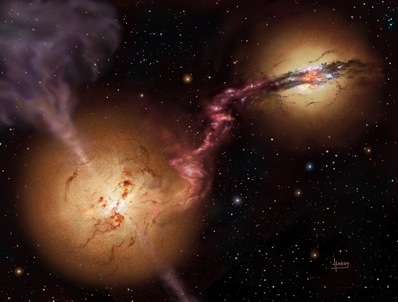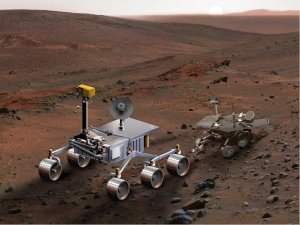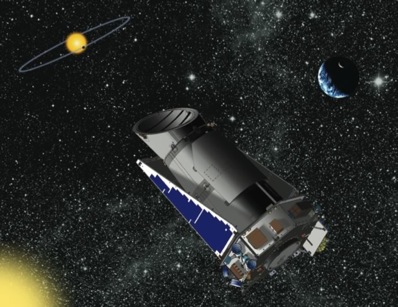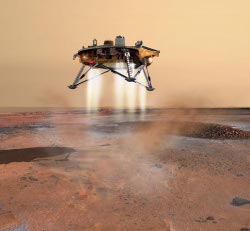BY STEPHEN CLARK
SPACEFLIGHT NOW
Posted: October 22, 2008 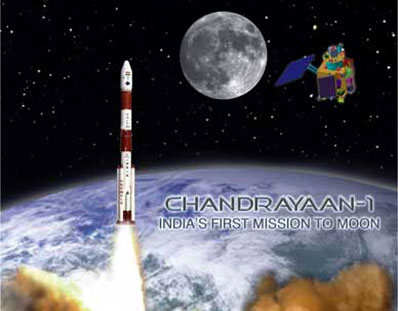
Credit: ISRO
|
India made the next giant leap in its space program early Wednesday with the launch of the country's first deep space mission, a probe to circle the moon with science gear from India, Europe and the United States.
The 3,042-pound Chandrayaan 1 spacecraft was launched at 0052 GMT Wednesday (8:52 p.m. EDT Tuesday) from the Satish Dhawan Space Center on Sriharikota Island on India's east coast.
The probe flew into space aboard a beefed-up Polar Satellite Launch Vehicle, a 146-foot-tall rocket originally built to haul Earth observation satellites into orbit.
The PSLV flew east from the launch site, propelling the spacecraft to a velocity of more than 20,500 mph and reaching an initial orbit with a high point of 14,205 miles and a low point of 158 miles. The inclination was about 17.9 degrees, according to the Indian Space Research Organization.
"Our baby is on the way to the moon," one engineer said a few minutes after the launch.
Engineers at the Chandrayaan 1 control center near Bangalore reported they had contacted the spacecraft moments after it was deployed from the rocket's fourth stage.
"This is an historic moment as far as India is concerned," said G. Madhavan Nair, ISRO chairman. "It was a remarkable performance by the launch vehicle. Every parameter was on the dot."
Senior ISRO officials spoke to the launch team shortly after the first portion of the mission was declared a success.
"What we have started is a remarkable journey for an Indian spacecraft to go to the moon and try to unravel (its) mysteries," Nair said. "I must take this opportunity to congratulate every one of you who have really contributed to this great success."
The final days before launch were plagued by monsoon rains, but the showers stopped long enough for officials to clear the rocket for launch at dawn Wednesday, Indian time.
"We have been fighting against all odds the past four days," Nair said.
Chandrayaan 1, India's first robotic mission to leave Earth orbit, will fire its own engine up to five times in the next two weeks to gradually reach a 250,000-mile-high orbit taking the spacecraft to the vicinity of the moon.
The probe will fire its engine again Nov. 8 to enter lunar orbit. The burn is scheduled to begin at about 1227 GMT (7:27 a.m. EST) to place Chandrayaan 1 in an oval-shaped parking orbit. That orbit will eventually be lowered to a circular path about 62 miles above the moon.
Plans call for Chandrayaan 1 to release a 64-pound impactor around Nov. 15 for a suicidal nosedive into the moon. The trip from orbit to the lunar surface will take about a half-hour, and the small craft will relay imagery, altitude information and spectral data back to Earth through the Chandrayaan mother ship.
Chandrayaan means "moon craft" in Sanskrit, the ancient language of India.
The $80 million mission is India's answer to a pair of lunar missions launched last year by Japan and China. Both countries' moon orbiters are still collecting imagery and scientific data.
But unlike the Japanese and Chinese missions, India invited large contributions from other nations to put instruments on Chandrayaan 1. Scientists from Europe and the United States answered the call.
More than half of the probe's 11 instruments come from outside India. The European Space Agency spent $8 million to fund three payloads, while NASA provided two more sensors. Bulgarian scientists also contributed a radiation monitor to the mission.
The payloads will be turned on and tested by the end of November before the spacecraft begins an operational mission lasting at least two years, officials said.
Scientists expect data from Chandrayaan 1 to help create the most detailed global chemical map of the moon showing mineral concentrations across the lunar surface. Researchers will also make a three-dimensional terrain map of the moon based on information yielded by the mission.
"We are going to look at the moon slightly differently than the people who are looking at it (now). We're looking at the moon very systematically," said Mylswamy Annadurai, Chandrayaan 1 project director at ISRO. "We're going to make a repository of the whole moon and its contents."
ESA's three instruments come from teams led by scientists in the United Kingdom, Germany and Sweden.
"In an era of renewed interest for the moon on a worldwide scale, the ESA-ISRO collaboration on Chandrayaan 1 is a new opportunity for Europe to expand its competence in lunar science while tightening the long-standing relationship with India - an ever stronger space power," said David Southwood, ESA director of science and robotic exploration.
The ESA-funded X-ray and near-infrared imaging spectrometers, called C1XS and SIR 2, will detect mineral signatures in soil on and just below the lunar surface. Both instruments are based on similar sensors that flew aboard Europe's SMART 1 spacecraft, which was deliberately crashed into the moon in 2006.
"European scientists will have the fantastic opportunity to continue our work on the moon," said Detlef Koschny, ESA's Chandrayaan 1 project scientist.
Europe's instruments aboard Chandrayaan 1 will work closely with other countries' payloads to help fill in the blanks in what scientists know about the moon.
"The Apollo missions went down to the surface, but only in a limited number of spots, whereas Chandrayaan tries to do detailed imaging of the entire sphere of the moon," said Christian Erd, ESA's Chandrayaan 1 project manager.
SARA, the other ESA payload, will observe solar wind particles contacting the moon's surface to study its effects on the top layer of soil.
NASA provided a pair of instruments, the Moon Mineralogy Mapper and the MiniSAR radar, as part of the agency's effort to return to robotic exploration of the moon.
"The opportunity to fly NASA instruments on Chandrayaan 1 undoubtedly will lead to important scientific discoveries," said Michael Griffin, NASA administrator. "This exciting collaboration represents an important next step in what we hope to be a long and mutually beneficial relationship with India in future civil space exploration."
The Moon Mineralogy Mapper, nicknamed M3, is a visual and near-infrared imaging spectrometer designed to plot mineral resources at higher resolutions than any instrument before. M3 scientists from the Jet Propulsion Laboratory hope the device will help them create mineral maps to find science-rich landing sites for future missions.
M3 will also look for direct evidence of pockets of water ice hidden inside craters near the lunar poles. Scientists believe there are frozen water deposits deep within the eternally dark craters due to high concentrations of hydrogen found there on previous missions.
The MiniSAR payload was developed by the Johns Hopkins University Applied Physics Laboratory. The instrument will bounce radar beams off the lunar surface to look for signs of water ice packed inside the walls of deep craters near the moon's poles.
The combination of data from the M3 and MiniSAR instruments will allow researchers to determine how many craters could harbor the frozen water, NASA officials said.
India's indigenous suite of science payloads include a terrain camera designed to take detailed black-and-white pictures of the whole lunar surface. The stereo camera will be able to spot features as small as about 16 feet, according to ISRO.
ISRO scientists also built two spectral imagers, one focusing on near-infrared and another in the X-ray range, to help produce precise global maps of the minerals and soil contents on the moon's surface.
A laser system was also bolted to the spacecraft to determine its altitude above the moon and chart lunar surface topography.
Indian engineers also constructed the moon impact probe.
"It has been the dream of Indian scientists to send a satellite around the moon and then collect more data about the surface features, minerals and so on," Nair said. "That dream is going to come true through this mission."
.
